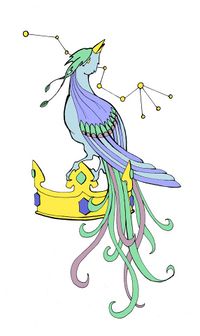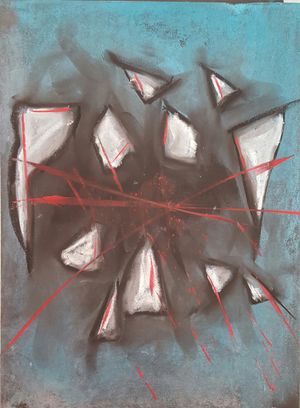Mark of Agramant
No edit summary |
mNo edit summary |
||
| Line 7: | Line 7: | ||
===Performing the Ritual=== | ===Performing the Ritual=== | ||
{{Casting time|2}} {{Target Character}} The ritual must involve the invocation of Agramant by at least three of his commonly-known names. | {{Casting time|2}} {{Target Character}} The ritual must involve the invocation of Agramant by at least three of his commonly-known names. | ||
__TOC__ | |||
===Effects=== | ===Effects=== | ||
This ritual places an enduring magical mark on the target character which can be perceived only with magical detection. The mark created by this ritual takes the form of an animal skull bleeding from the eye sockets. | This ritual places an enduring magical mark on the target character which can be perceived only with magical detection. The mark created by this ritual takes the form of an animal skull bleeding from the eye sockets. | ||
Revision as of 21:51, 17 April 2023
While Agramant is subject to the enmity of the Imperial Conclave, it is illegal to perform this ritual.
Rules
Winter Magnitude 4
Urizen Lore
This ritual is part of Urizen lore rather than Imperial Lore. Any Urizen character with the appropriate lore can master or perform this ritual. A character from another nation who mastered the ritual before it became part of Urizen lore may still perform it, but does so under the usual rules for performing a ritual learned from a ritual text.
Performing the Ritual
Performing this ritual takes at least 2 minutes of roleplaying. This ritual targets a character, who must be present throughout. The ritual must involve the invocation of Agramant by at least three of his commonly-known names.
Effects
This ritual places an enduring magical mark on the target character which can be perceived only with magical detection. The mark created by this ritual takes the form of an animal skull bleeding from the eye sockets.
A mark of Agramant can be detected by a detect magic spell cast on the character for that specific purpose (a detect magic spell cast for any other purpose does not reveal the mark). If the caster of the detect magic also bears a mark of Agramant then they discover that their marks are the same; otherwise they discover nothing.
The mark of Agramant is not restricted to any part of the target's body; it cannot be hidden from detection by covering it up.
The mark of Agramant remains, the only known way of removing it is from the touch of Agramant; it may even persist through death.
Assurance
This particular instance this ritual will cease to function if the Conclave were to ever grant the Voice of the Pines Amity.
Description
This ritual clearly functions in a similar manner to the Autumn ritual Arcane Mark, and is most likely intentionally developed as a reflection it. The ritual "marks" a person with a symbol which can only be recognised by somebody else bearing the same mark. There are notes in the original text that this was the first ritual that the Childre of the Black Drop learnt in their attempts to understand the nature of Agramant, and the danger he possessed. By bearing the mark, they were able not only to allay the suspicion of his followers, but use [detect magic]] to determine if someone had bound themselves to Agramant. While their intentions may have been simply to study Agramant, it is clear from later developments that they quickly succumbed to the temptation to try and use the boons Agramant offered, and then in turn to their own ambitions and cruelties: this was by no means the last ritual of Agramants lore that they mastered.
The Mark of Agramant entered Urizen lore shortly before the Winter Solstice 384YE, as part of a book entitled Ceremonies of the Black Drop Society. The attendants of the Great Library were deeply uncomfortable with the rituals in that book and their presence among Urizen lore, more due to their illegal nature than any sentimental concerns about their origin. They were apparently all submitted at the same time as Treacher's Quill, but Phaleron itself intervened to delay their appearance in lore while it pondered how best to respond. In the end it decided to do the only reasonable thing; present the rituals to the Urizen as part of their lore as agreed when the lore was established. The Celestial Library does not enjoy causing trouble for its Urizeni allies, but the Gift of Knowledge is available to every Imperial citizen; it cannot pick and choose who can contribute rituals via the ritual.
The Childer of the Black Drop were a sorcerous cabal of magicians well-versed in Winter lore who were committed to collecting every scrap of lore they could find about the eternal Agramant. While they claimed to be seeking some kind of weakness that could be exploited to protect the Empire completely from his depredations, all thirteen members were - perhaps inevitably - declared sorcerers by the Imperial Conclave in Summer 354YE. In pursuit of their quest they had apparently used magic in very unwise ways - mastering rituals that drew on the power of Blood-on-the-Snow to "better understand his dark temptations". They were unrepentant, and eight of their members were killed in the resulting fracas. Five of them - Johann Perivale von Sarvos, Wilhelm Ecaso di Temeschwar, Padik Tarvin of Tassato Mestra, Tomazi duPain de Holberg, and Jodeya Watiker di Tassato Mestra - were unaccounted for. Shortly before the Summer Solstice 384YE, the bodies of four of the remaining members were discovered in a cottage in the Vardstein Vale. The final surviving Child of the Black Drop - Jodeya Watiker di Tassato Mestra was only recently accounted for, and there is speculation that she may have been responsible for using Gift of Knowledge to place this wicked ritual into Urizen lore.
Common Elements
The most common tradition used in performances of this ritual is goetia calling on Agramant to mark the target, given the requirement to include three of his names in the performance. Ritualists who practice astronomancy will often call on the constellations of the Three Sisters, representing ties of blood and consequences, or the Spider, representing eternals. Dramaturgy lends itself to the Prince, with a ritualist taking on that role representing Agramant himself while marking the target physically with the Ring specially prepared for that purpose, often in the context of the characters swearing an oath together.

